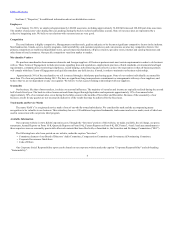Kohl's 2015 Annual Report Download - page 5
Download and view the complete annual report
Please find page 5 of the 2015 Kohl's annual report below. You can navigate through the pages in the report by either clicking on the pages listed below, or by using the keyword search tool below to find specific information within the annual report.
Table of Contents
Any amendment to or waiver from the provisions of the Code of Ethics that is applicable to our Chief Executive Officer, Chief Financial Officer or
other key finance associates will be disclosed on the “Corporate Governance” portion of the website.
Information contained on our website is not part of this Annual Report on Form 10-K. Paper copies of any of the materials listed above will be provided
without charge to any shareholder submitting a written request to our Investor Relations Department at N56 W17000 Ridgewood Drive, Menomonee Falls,
Wisconsin 53051 or via e-mail to Investor.Relations@Kohls.com.
Forward-Looking Statements
This Form 10-K contains “forward-looking statements” made within the meaning of the Private Securities Litigation Reform Act of 1995. Words such as
"believes," "anticipates," "plans," "may," "intends," "will," "should," "expects" and similar expressions are intended to identify forward-looking statements.
Forward-looking statements also include comments about our future sales or financial performance and our plans, performance and other objectives,
expectations or intentions, such as statements regarding our liquidity, debt service requirements, planned capital expenditures, future store initiatives,
adequacy of capital resources and reserves and statements contained in the "2016 Outlook" section of "Management's Discussion and Analysis of Financial
Condition and Results of Operations". There are a number of important factors that could cause our results to differ materially from those indicated by the
forward-looking statements including, among others, those risk factors described below. Forward-looking statements relate to the date made, and we
undertake no obligation to update them.
Our sales, gross margin and operating results could be negatively impacted by a number of factors including, but not limited to those described below.
Many of these risk factors are outside of our control. If we are not successful in managing these risks, they could have a negative impact on our sales, gross
margin and/or operating results.
•Declines in general economic conditions, consumer spending levels and other conditions could lead to reduced consumer demand for our
merchandise.
Consumer spending habits, including spending for the merchandise that we sell, are affected by many factors including prevailing economic
conditions, levels of employment, salaries and wage rates, prevailing interest rates, housing costs, energy and fuel costs, income tax rates and policies,
consumer confidence, consumer perception of economic conditions, and the consumer’s disposable income, credit availability and debt levels. The
moderate income consumer, which is our core customer, is especially sensitive to these factors. A continued or incremental slowdown in the U.S.
economy and the uncertain economic outlook could continue to adversely affect consumer spending habits. As all of our stores are located in the United
States, we are especially susceptible to deteriorations in the U.S. economy.
Consumer confidence is also affected by the domestic and international political situation. The outbreak or escalation of war, or the occurrence of
terrorist acts or other hostilities in or affecting the United States, could lead to a decrease in spending by consumers.
•Actions by our competitors.
The retail industry is highly competitive. We compete for customers, associates, locations, merchandise, services and other important aspects of our
business with many other local, regional and national retailers. Those competitors include traditional department stores, upscale mass merchandisers, off-
price retailers, specialty stores, internet and catalog businesses and other forms of retail commerce.
We consider style, quality and price to be the most significant competitive factors in our industry. The continuing migration and evolution of
retailing to on-line and mobile channels has increased our challenges in differentiating ourselves from other retailers especially as it relates to national
brands. In particular, consumers are able to quickly and conveniently comparison shop with digital tools, which can lead to decisions based solely on
price. Unanticipated changes in the pricing and other practices of our competitors may adversely affect our performance.
5


















